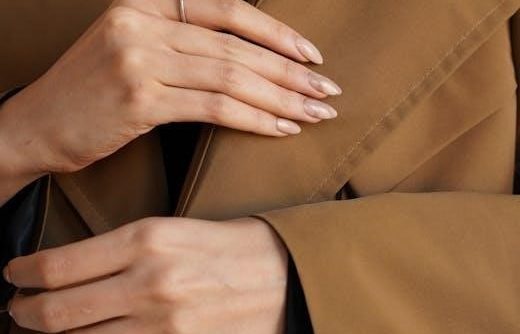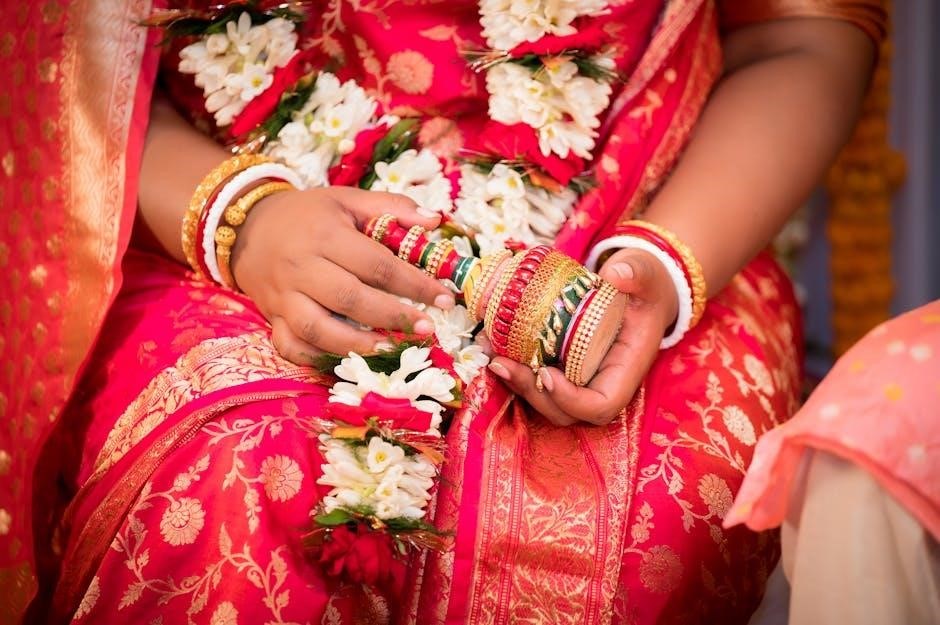
Understanding Wrist Size and Its Importance
Understanding wrist size is crucial for selecting watches and jewelry that fit comfortably and look great. Proper fit ensures comfort, style, and functionality, making it essential for everyday wear.
How Wrist Size Affects Watch and Jewelry Fit
Wrist size plays a key role in determining the fit of watches and jewelry. A watch or bracelet that is too tight can cause discomfort, while one that is too loose may slip or look unflattering. Proper sizing ensures the accessory stays securely in place without restricting movement. For watches, the case diameter and band length must align with the wrist circumference to avoid a bulky or overwhelmed appearance. Similarly, jewelry like bracelets and bangles require precise measurements to ensure evenly spaced charms and a balanced look. Understanding your wrist size helps you choose accessories that complement your proportions, ensuring both comfort and style.
Why Measuring Your Wrist Accurately Matters
Accurate wrist measurement is essential for ensuring a proper fit for watches and jewelry. Incorrect sizing can lead to discomfort, as a too-tight accessory may restrict movement, while a too-loose one may slip off. Precise measurements ensure the accessory sits comfortably and functions as intended, such as a watch staying securely in place. Additionally, accurate sizing enhances the aesthetic appeal, making the piece look proportionate to your wrist. Proper measurement also prevents potential damage to the accessory from being overly tight or loose. Taking the time to measure correctly ensures a balance of comfort, functionality, and style.

How to Measure Your Wrist Size
To measure your wrist size, wrap a flexible tape measure snugly around the narrowest part of your wrist, just above the wrist bone. Ensure a comfortable fit for accuracy.
Using a Flexible Tape Measure
Using a flexible tape measure is the most accurate way to determine your wrist size. Wrap the tape snugly around the narrowest part of your wrist, just above the wrist bone. Ensure the tape is level and not too tight or loose. This method provides a precise measurement, essential for selecting watches or jewelry that fit comfortably. For the best results, bend your wrist slightly downward while measuring to simulate how a watch or bracelet would naturally sit. Record the measurement in inches or centimeters for reference when choosing your accessories.
Measuring Without a Tape Measure
If you don’t have a tape measure, you can use a string or a flexible strip of paper. Wrap it around your wrist at the narrowest point, just above the wrist bone, ensuring it’s snug but not tight. Mark the point where the string overlaps with a pen or finger. Lay the string flat and measure the marked length using a ruler. This method provides an accurate alternative to a tape measure, helping you determine your wrist size for watches or jewelry. It’s a simple yet effective way to ensure a proper fit without specialized tools.
Factors That Influence Wrist Size
Wrist size is influenced by genetics, gender, age, and overall body proportions. Generally, men tend to have larger wrists than women due to bone structure and muscle mass. Age can also play a role, as wrists may become slightly larger with weight gain or muscle development. Additionally, wrist size varies naturally among individuals, even within the same gender or age group. Understanding these factors helps in selecting watches or jewelry that complement your wrist proportions, ensuring a balanced and stylish appearance. Accurate measurement is key to finding the perfect fit.

Watch Size Chart: Finding the Perfect Fit
A watch size chart helps match your wrist circumference with standard sizes, ensuring comfort and style, while considering factors like lug-to-lug measurement for a perfect fit.
Standard Watch Sizes for Different Wrists
Standard watch sizes range from small to extra-large, catering to various wrist sizes. Small watches (34-36mm) suit slender wrists, while medium (37-39mm) and large (40-42mm) fit average to slightly larger wrists. Extra-large watches (43mm+) are ideal for broader wrists. These sizes ensure comfort and style, with proper fit enhancing both aesthetics and functionality. Choosing the right size ensures the watch sits comfortably without slipping or feeling too tight, making it essential for everyday wear.
How to Choose a Watch Based on Wrist Circumference
Choosing a watch based on wrist circumference ensures a perfect fit and balance. Measure your wrist accurately using a flexible tape measure or a string. Compare the measurement to a watch size chart to determine the ideal case diameter. For smaller wrists (6-7 inches), opt for 34-36mm watches, while medium wrists (7-7.5 inches) suit 37-39mm; Larger wrists (7.5-8 inches+) can accommodate 40mm or larger. Consider personal style and comfort, ensuring the watch complements your wrist without slipping or feeling too tight. Proper fit enhances both aesthetics and functionality.
The Role of Lug-to-Lug Measurement
Lug-to-lug measurement is the distance between the watch lugs, crucial for ensuring the watch sits comfortably on the wrist. It affects how the watch appears proportionally and prevents it from looking too large or small. Measure this distance using a ruler or calipers to ensure the watch complements your wrist size. A well-balanced lug-to-lug measurement enhances both aesthetics and comfort, making it a key factor in selecting the perfect timepiece. Always consider this measurement alongside wrist circumference for a harmonious fit.

Bracelet and Jewelry Sizing Guide
Measuring Your Wrist for Bracelets
To measure your wrist for bracelets, use a flexible tape measure or a strip of paper. Wrap it snugly around the narrowest part of your wrist, just above the wrist bone. Ensure the fit is neither too tight nor too loose. For charm bracelets, add 1-2 cm to the measurement to allow space between charms. For bangles or cuffs, measure the widest part of your hand to ensure the bracelet can slide on easily. This method ensures a comfortable and stylish fit, whether for delicate chains or statement pieces.

How to Ensure Proper Charm Spacing
Proper charm spacing ensures your bracelet looks balanced and polished; Start by measuring your wrist and adding 1-2 cm for charm spacing. For smaller wrists, 1 cm is ideal, while larger wrists can accommodate up to 3 cm. Consider the size and number of charms; too many can overcrowd the bracelet. Space charms evenly, leaving enough room for movement without overlapping. Larger charms may require more space, while smaller ones can be grouped together. This ensures a harmonious design that complements your wrist size and personal style.

Bracelet Size Chart for Various Wrists
A bracelet size chart helps determine the ideal fit based on wrist circumference. Small wrists (14-16 cm) suit slim designs, while medium wrists (16-18 cm) fit standard bracelets. For larger wrists (18-20 cm), bold or adjustable styles are recommended. Extra-large wrists (20+ cm) require extended or custom sizes. Measure your wrist, then add 1-2 cm to ensure comfort and easy movement. This ensures the bracelet sits nicely without feeling too tight or slipping off. Proper sizing enhances both comfort and aesthetic appeal, making it essential for choosing the right bracelet.

International Wrist Size Standards
Wrist sizes vary globally, with regional differences influencing standard measurements. The watch and jewelry industry uses standardized charts to cater to diverse wrist sizes worldwide, ensuring a perfect fit for everyone.
Comparing Wrist Sizes Across Different Regions
Wrist sizes vary significantly across different regions, influenced by genetics and lifestyle. In Asia, smaller wrist sizes are common, with average measurements ranging from 6 to 7 inches. In contrast, Western countries often see larger wrist sizes, typically between 7 and 8.5 inches. Europe and America have similar averages, while African and Middle Eastern regions show diverse measurements due to varied demographics. Understanding these regional differences is crucial for manufacturers to cater to global markets effectively. This ensures watches and jewelry are designed to fit comfortably across diverse populations, enhancing both aesthetics and functionality worldwide.
Global Size Charts for Watches and Jewelry
Global size charts for watches and jewelry provide standardized measurements to ensure a universal fit. These charts often include wrist circumference ranges, bracelet lengths, and watch case sizes. Manufacturers use these standards to cater to diverse markets, ensuring consistency across regions. For example, a watch with a 7-inch wrist size in the U.S. may correspond to a medium size in Europe or a large size in Asia. These charts help consumers choose the right fit regardless of their location, promoting comfort and style worldwide. They also aid in online shopping, where fit is a key consideration.
Understanding your wrist size ensures comfort and style. Use size charts, measure accurately, and consider personal preferences for the perfect fit in watches and jewelry.
Key Takeaways for Choosing the Right Wrist Size
Accurate wrist measurements are essential for a comfortable and stylish fit. Use size charts to guide your selection, ensuring watches and jewelry complement your wrist proportions. Consider watch thickness for comfort and bracelet flexibility for charm spacing. Proper fit enhances both functionality and aesthetics, making it crucial for everyday wear and special occasions. Always balance personal style with practicality to find the perfect match for your wrist size and preferences.
Additional Tips for a Perfect Fit
For a perfect fit, consider your wrist shape and proportions. Ensure watches and bracelets are neither too tight nor too loose. Try on pieces if possible, and opt for adjustable straps or bracelets for versatility. Measure at the narrowest part of your wrist for accuracy. Consider thickness for watches, as it affects comfort. For bracelets, leave space for charms to move freely. Balance style with practicality, ensuring the piece complements your wrist size and personal aesthetic. These tips guarantee a comfortable and flattering fit for any accessory.